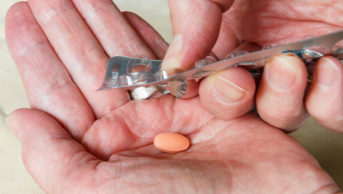
Shutterstock.com
The ongoing controversy over whether healthy people should take cholesterol-lowering statin drugs to prevent heart disease has become intense, more so in the UK than in the United States (even though US guidelines call for broader statin use). There is a lack of clarity on whether national clinical guidelines are based on sufficient scientific evidence. This uncertainty impedes the ability of doctors and pharmacists to assist people in determining when and how to take medicines and determine if long-term statin use provides more benefit than harm — a great disservice to the public.
Beyond the public health urgency, the controversy over whether the new National Institute for Health and Care Excellence (NICE) guidance for reducing cholesterol will do more harm than good for people at low risk of cardiovascular disease (CVD) reveals a lack of transparency in scientific research. It may also reflect the influence of commercial interests in communicating what medical science purportedly shows.
The statin confusion
In January 2006, the UK’s then National Institute for Clinical Excellence (now NICE) issued its first guidance on the use of statins for the prevention of cardiovascular events. NICE recommended statin therapy for people who already had clinical evidence of CVD, whose ten-year risk of developing CVD was 20% or greater, or whose risk was increased because of diabetes or by being in high-risk ethnic groups.
The NICE guidance was consistent with the recommendations issued in Australia in 2001, which called for statin therapy in people whose five-year risk of CVD was 10–15% after attempts to modify risk through positive lifestyle change. The US guidelines issued in 2001 lowered the threshold of eligibility, calling for treatment of people without heart disease whose ten-year risk was 10–20%, who had two or more coronary heart disease (CHD) risk factors and low-density lipoprotein (LDL) ≥ 130mg/dL (3.36mmol/L).
A 2011 Cochrane review of statins for the primary prevention of CVD was consistent with the UK’s NICE recommendations[1]
. The review concluded that existing evidence did not support the use of cholesterol-lowering statins for people with less than a 20% ten-year risk of CVD.
Well informed pharmacists can play an important role in helping otherwise healthy people determine for themselves whether initiating or continuing statin therapy is in their best interest.
But in 2013, the Cochrane review took a radical turnabout. It concluded that statins reduce all-cause mortality and cardiovascular events without increasing the risk of adverse events among people at low risk of CVD — less than 10% risk over ten years[2]
. Although the results of four additional clinical trials were included in the 2013 review, they did not substantially alter the previously documented effect of statin therapy. Instead, the change in the 2013 Cochrane review was based largely on a meta-analysis by the Cholesterol Treatment Trialists’ (CTT) Collaboration, published in 2012[3]
.
According to the Cochrane review, the 2012 CTT Collaboration further demonstrated a consistent 20% relative risk reduction in major vascular events with statins per 1mmol/L reduction in LDL cholesterol, regardless of baseline risk. It claimed that men and women, old and young, and people with and without CVD all appear to benefit, and that the evidence resolved concerns about possible serious adverse effects and potential sources of bias in the randomised trials highlighted in an earlier version of this Cochrane review[4]
.
Both US and UK guidelines followed suit. The US guidelines expanded the number of healthy people for whom statins were indicated by around 13 million, calling for treatment of people with a 7.5% or greater ten-year risk, regardless of baseline LDL level[4]
. The NICE guideline issued in July 2014 lowered the threshold of CVD risk for statin therapy in healthy people from 20% down to a 10% ten-year risk[5]
, increasing the number of people for whom statins were recommended by 4.5 million. Shortly thereafter, the General Practitioners Committee (GPC) of the British Medical Association issued a statement expressing concern “that there is insufficient evidence of significant overall benefit to low-risk individuals to allow GPs to have confidence in the recommendation to reduce the risk-threshold for prescribing cholesterol-lowering drugs”.[6]
Results of a survey of 560 British GPs published in October 2014 showed that two-thirds “had not begun prescribing statins at the 10% risk threshold”[7]
.
Re-evaluating the evidence
Anticipating the impact of the 2013 Cochrane review’s radical shift on the benefit of statin therapy, regardless of baseline risk while purportedly allaying concerns about adverse events, my colleagues and I re-evaluated the 2012 CTT meta-analysis and published our results in The
BMJ in October 2013[8]
. We found that, for people with less than a 10% five-year CVD risk, there was not a significant reduction in overall mortality. We also found that 140 people with a five-year risk of less than 10% need to be treated with statins for five years in order to prevent one heart attack or stroke, with no reduction in overall mortality and no reduction in serious adverse events.
Thus, with no net benefit — just a minor reshuffling of serious illness — we concluded that any harm from statins tipped the equation in the negative direction. We reported on muscle symptoms (including misinterpreting an epidemiological study, which we later corrected), diabetes, liver dysfunction, acute renal failure, cataracts, sexual dysfunction and psychiatric symptoms.
CTT was not pleased with our article. On 21 March 2014, Sir Rory Collins, professor of medicine and epidemiology at the Clinical Trial Service Unit within the University of Oxford and head of the CTT collaboration, told The Guardian our paper in The
BMJ was “a serious disservice to British and international medicine”. He also said it was probably killing more people than a retracted paper that had connected the measles, mumps and rubella vaccine with autism, for which the author had been found to have acted dishonestly and irresponsibly.
“I would think the papers on statins are far worse in terms of the harm they have done,” said Sir Collins. “We have really good data from over 100,000 people that show that the statins are very well tolerated. There are only one or two well documented [problematic] side effects.”
That was then. Less than a year later, on 15 February, 2015, the Sunday Express reported that Sir Collins had stated in an email “that his team had assessed the effects of statins on heart disease and cancer but not other side effects such as muscle pain”.
Whence comes the controversy?
The seed that has blossomed into this ugly controversy was planted in the mid-1990s. An article published in the American Journal of Cardiology by the CTT group explained that patient-level meta-analysis of the efficacy of statins to reduce total mortality “should be of sufficient statistical power to assess reliably the separate effects on fatal and total (i.e. fatal and non-fatal) CAD [coronary artery disease] among a number of special interest groups (e.g. those with different levels of CAD risk, women)”[9]
.
Two inherent flaws would eventually emerge in CTT’s arrangement with the clinical trialists (in the context of all but one of the studies having been largely or entirely commercially funded). Firstly, the CTT agreed that the patient-level data upon which their analyses would be based “will be held in strict confidence”, meaning that it would not be shared without the permission of those who conducted the studies. So the CTT, part of the Clinical Trial Service Unit of Oxford, which is heavily dependent on pharmaceutical company money for its research, was given sole access to patient-level data without allowing for review by independent experts or even the possibility of adequate peer review of its published meta-analyses.
Secondly, although evaluation of the effectiveness of medicines must always be counterbalanced by evidence of harm, the CTT’s arrangement to receive effectiveness data did not have such balance. As reported in their 1995 article, CTT would only receive adverse event data on cancer and reasons for stopping study treatment. The frequency of adverse events cited in the 2012 CTT meta-analysis relied upon published reports rather than patient-level data.
So what now?
The 2013 Cochrane review relied upon the 2012 CTT meta-analysis and published articles, but did not have access to the patient-level data. Similarly, the NICE guideline expert panel (8 out of 12 of whom had financial ties to statin manufacturers[10]
) did not have access to patient-level data. In fact, even the CTT did not have patient-level data for most adverse events.
The bottom line is that practically all that we think we know about the efficacy and safety of statins has been brought to us by commercial interests that hold the actual data as proprietary secrets. Since we cannot verify commercial claims of efficacy and safety, healthy people should use statins with caution. Recommendations should not be simplistic binary data, rather they should provide the best possible evidence of the likelihood of benefit and potential of harm to help optimise personal choice.
As our paper in The BMJ stated, healthy people with less than a 20% risk of CVD do not derive a net health benefit from statins. Although there is a slight change in what they get sick from, there is no significant change in the age at which they die. These statements were based on the data available to us, which is far less than what CTT had, and is again less than what the manufacturers have. It is critically important to acknowledge the extent to which lack of access to proprietary patient-level data compromises medical practice. An independent panel appointed by the editor of The BMJ ruled unanimously (6 to 0) against Sir Collins’ request for retraction of our re-analysis of the 2012 CTT meta-analysis.
Well informed pharmacists can play an important role in helping otherwise healthy people determine for themselves whether initiating or continuing statin therapy is in their best interest. British GPs are to be congratulated for their widespread resistance to unquestioned adoption of the new NICE guideline.
Although the situation with statins seems singularly chaotic, the bad news is that it is not at all unique. It is just the example du jour of the extent to which the primary function of medical information has become tipped toward serving commercial rather than public interest. Medical science will not best serve the public interest until its findings are completely transparent.
References
[1] Taylor F, Ward K, Moore THM et al. Statins for the primary prevention of cardiovascular disease. Cochrane Database Syst Rev 2011;1:CD004816.
[2] Taylor F, Huffman MD, Macedo AF et al. Statins for the primary prevention of cardiovascular disease. Cochrane Database Syst Rev 2013;1:CD004816.
[3] Cholesterol Treatment Trialists’ (CTT) Collaborators. The effects of lowering LDL cholesterol with statin therapy in people at low risk of vascular disease: meta-analysis of individual data from 27 randomised trials. The Lancet 2012;380:581–590.
[4] Stone NJ, Robinson JG, Lichtenstein AH et al. 2013 ACC/AHA guideline on the treatment of blood cholesterol to reduce atherosclerotic cardiovascular risk in adults: a report of the American College of Cardiology/American Heart Association Task Force on Practice Guidelines. Circulation 2014;129(2):S1–S45.
[5] NICE guidelines [CG181]. Lipid modification: cardiovascular risk assessment and the modification of blood lipids for the primary and secondary prevention of cardiovascular disease. July 2014.
[6] GPC statement on NICE Lipid Modification Clinical Guidance CG181. 18 July 2014.
[7] Price C. Two-thirds of GPs disregard NICE advice to offer statins to more patients. Pulse 22 October 2014.
[8] Abramson J, Rosenberg HG, Jewell N et al. Should people at low risk of cardiovascular disease take a statin? The BMJ 2013;347:f6123. doi: 10.1136/bmj.f6123.
[9] Cholesterol Treatment Trialists’ (CTT) Collaboration. Protocol for a prospective collaborative overview of all current and planned randomized trials of cholesterol treatment regimens. American Journal of Cardiology 1995;75:1130–1134.
[10] NICE. Draft for consultation. Lipid modification: appendices. 2014.


